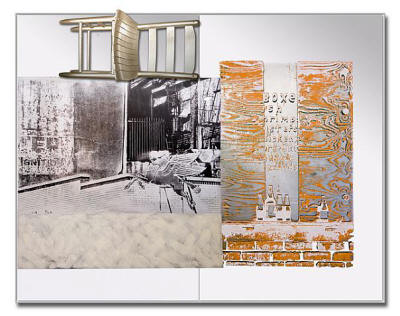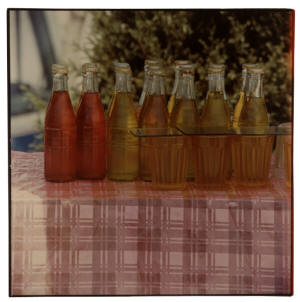University
Communications
Office
Arkansas State University
Jonesboro,
Arkansas
Staff
Markham Howe
Sara McNeil
Gina Bowman
(870) 972-3056
fax (870) 972-3693
More information:
NewsPage
Links to News Releases
& Announcements
Campus Calendar
Public activities at ASU
About
ASU
Overview, history
and more |
‘BOB! A Tribute to Robert Rauschenberg opens at Bradbury
Gallery March 12
March 5, 2009 --
In May of 2008, one of
America’s best-known artists, Robert Rauschenberg, died. Arkansas State
University-Jonesboro's Bradbury Gallery, located in Fowler Center, 201
Olympic Drive, Jonesboro, will host an exhibition that is a tribute to
this significant American artist. “BOB! A Tribute to Robert
Rauschenberg” opens on Thursday, March 12, at 5 p.m. with a reception.
Both the reception and the exhibition are free and open to the public.
The exhibition runs through Friday, April 17.
Milton Ernest Rauschenberg was born in Port Arthur, Texas on October 22,
1925. He changed his name from Milton to Bob, ultimately becoming known
by the more formal Robert.
He studied art in several venues--at the Kansas City Art Institute,
briefly and informally in Paris after World War II, and in the late
1940s at Black Mountain College in North Carolina. It was at Black
Mountain that he met his wife, Susan Weil, and his longtime friend,
musician John Cage. Together, they helped to begin what ultimately
became an artistic revolution.
Looking for a vibrant art scene, Rauschenberg moved to New York in the
1950s, where his interest in popular culture and his dismissal of the
solemnity of the
Abstract Expressionists led him to search for a new way of
painting. Much like Marcel Duchamp and an earlier generation of artists, he began to work with
non-traditional materials that were readily available to him. From house
paint to found objects, he covered his canvases creating what he termed
“combines.” This way of working, more commonly known as assemblage, is a
three-dimensional process, which joins objects to a canvas or structure,
much like the two-dimensional process of collage. This style of work
brought him prominence as an artist, and throughout his lifetime, it
remained his signature.
Duchamp and an earlier generation of artists, he began to work with
non-traditional materials that were readily available to him. From house
paint to found objects, he covered his canvases creating what he termed
“combines.” This way of working, more commonly known as assemblage, is a
three-dimensional process, which joins objects to a canvas or structure,
much like the two-dimensional process of collage. This style of work
brought him prominence as an artist, and throughout his lifetime, it
remained his signature.
In the 1960s, as Pop Art
began to emerge, he less frequently worked in a purely three-dimensional
manner. He collaged onto canvas cut-outs from magazines, overlaid by
 silk-screen
prints and paint. These collages often used politically charged images
or faces, creating a commentary about society and popular culture. silk-screen
prints and paint. These collages often used politically charged images
or faces, creating a commentary about society and popular culture.
In the 1970s and 1980s, his use of two-dimensional collage led him to
printmaking and photography. In 1985, he began a six-year travelling
exhibition called the Rauschenberg Overseas Cultural Interchange, or
ROCI, dedicated to world peace and cultural awareness through
collaborative art-making. His self-financed, evolving exhibition
brought him to 22 countries including Mexico, Malaysia, the former East
Germany, the former Soviet Union, Cuba, Japan, China, Tibet, Venezuela,
Chile, and the U.S., culminating in an exhibition at the National
Gallery of Art in Washington DC. Several works from the ROCI series are
included in the Bradbury Gallery exhibition.
Other Rauschenberg works included in the exhibition are from the Chow
Bag series. Much like the ROCI series, this set of collaged silk-screens
conveys his concern about society, human rights, and social injustice.
In order to create a context in which the viewer can better understand
Rauschenberg’s place in the art world, works by several of his
contemporaries -- Vito Acconci, Chuck Close, Jim Dine, Robert
Mapplethorpe, and James Rosenquist -- are also included in the
exhibition.
Inspired by the work that Rauschenberg was doing, Jim Dine moved to New
York in the 1950s, where he too began to work in assemblage. Dine,
Rosenquist, Rauschenberg, and others were interested in familiar
imagery, slogans, and images found in mass media. Much like the earlier
Dada movement, these “Pop” artists incorporated found objects into their
work. Any image or object from popular culture was fair game as
artistic material for these artists.
To some degree, Rauschenberg and Mapplethorpe were both influenced by
Andy Warhol. Mapplethorpe was also interested in photographic imagery of
contemporary culture, and he, too, incorporated clippings from magazines
and books in his early work. This interest led him to photography, but
originally he used his photos as a collage element in his paintings
rather than as works of art in and of themselves. The transformation to
photography was a slow process, eventually becoming his sole means of
art making.
Rauschenberg’s talents extended far beyond painting, sculpture,
photography, and printmaking. He was a performance artist; acted as a
sort of ambassador for world peace and social awareness with his ROCI
program; greatly influenced and inspired numerous artists; and won a
Grammy for the cover of Speaking in Tongues, an album by the group
Talking Heads. Rauschenberg died at his home in Captiva, Florida, at
the age of 82, with his place in art history firmly established.
The works of art included in this exhibition are selections from the
Tennessee State Museum, the Arkansas Arts Center, and the ASU Permanent
Collection of Art.
Bradbury Gallery hours are 12 noon to 5 p.m. Tuesday-Saturday and 2-5
p.m. on Sunday. The Bradbury Gallery is closed on Mondays. For
additional information, contact
Les Christensen, director of the Bradbury Gallery, at (870)
972-2567, or by e-mail at
lchristensen@astate.edu.
###
Images from top:
Robert Rauschenberg
Pegasits / ROCI USA (Wax Fire Works) 1990
acrylic, fire wax, chair on stainless steel
72.75 x 96.75 x 17.5 inches
courtesy of The Tennessee State Museum
Robert Rauschenberg
Study for a Chinese Summerhall (Bottles), 1983
photographic print
26.375 x 26.5 inches
courtesy of The Tennessee State Museum
|
